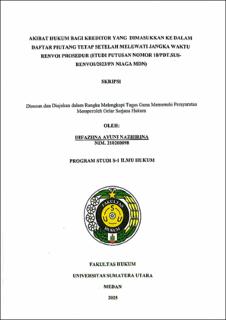| dc.contributor.advisor | Ginting, Budiman | |
| dc.contributor.advisor | Murti Lubis, Tri | |
| dc.contributor.author | Ayuni Nazhirina, Ihfazhna | |
| dc.date.accessioned | 2025-07-17T07:57:43Z | |
| dc.date.available | 2025-07-17T07:57:43Z | |
| dc.date.issued | 2025 | |
| dc.identifier.uri | https://repositori.usu.ac.id/handle/123456789/105716 | |
| dc.description.abstract | Creditors have the right to collect their receivables through the mechanism set by
the ICC Law. One of the crucial stages in resolving bankruptcy is the preparation of
the Fixed Receivables List (DPT), which determines which creditors are entitled to
receive payments from the bankruptcy debtor's assets. However, in practice, there are
often problems where creditors are not recognized in the list, either due to negligence,
administrative errors, or unclear receivables verification procedures. This condition
has the potential to cause significant legal consequences for creditors, including the
loss of the right to repay receivables. This study aims to analyze the legal
consequences for creditors who are listed in the Fixed Receivables List after passing
the renvoi procedure period, focusing on the case study of PT Ricky Kurniawan
Kertapersada based on Decision Number 18.Pdt. Sus-Renvoi/2023/PN Niaga Mdn.
This study uses a normative legal method with a legislative and case approach to
understand in depth the legal implications of not including creditors in the Fixed
Receivables List. The data sources used consisted of primary, secondary, and tertiary
legal materials that were analyzed using descriptive-analytical methods. With this
approach, the study evaluates the legal basis related to the mechanism for compiling
the Fixed Receivables List, the procedure for submitting objections through a
procedural renvoi, as well as the legal implications that arise for creditors who have
lost their collection rights.
The results of this study show that KLHK’s efforts to propose procedural review
efforts are irrelevant. Renvoi procedures can only be submitted within the deadline
before or at the time of the receivables matching meeting. As a result of KLHK not
submitting a renvoi within the specified time, the only legal remedy available to KLHK
is through other lawsuits as stipulated in Article 3 Paragraph (1) of the PKPU Law.
Thus, the use of the renvoi mechanism by KLHK has expired and cannot be used as a
basis for changing the status of receivables that have been recognized in the DPT. The
main problem in this case lies in the judge's decision which actually granted the
objection of KLHK on the basis of procedural renvoi and designated KLHK as a
creditor, even though the renvoi in this case is legally irrelevant and inappropriately
used. This actually creates inconsistencies with the bankruptcy legal framework that
strictly regulates time limits and procedures in the verification and recognition
process of receivables. The judge should have rejected the objection application
because it did not comply with the provisions stipulated in the UUK-KPU and
encouraged KLHK to take other lawsuit channels as a legal mechanism according to
the law. | en_US |
| dc.language.iso | id | en_US |
| dc.publisher | Universitas Sumatera Utara | en_US |
| dc.subject | Bankruptcy | en_US |
| dc.subject | List of Fixed Receivables | en_US |
| dc.subject | Creditors | en_US |
| dc.subject | Renvoi Procedure | en_US |
| dc.title | Akibat Hukum Bagi Kreditor yang Dimasukkan ke Dalam Daftar Piutang Tetap Setelah Melewati Jangka Waktu Renvoi Prosedur (Studi Putusan Nomor 18/Pdt.Sus Renvoi/2023/PN Niaga Mdn) | en_US |
| dc.title.alternative | Legal Consequences For Creditors Included Into The List Of Receivables After The Period Of The Renvoi Procedure (Study Of Decision Number 18/Pdt.Sus.Renvoi/2023/PN Niaga Mdn) | en_US |
| dc.type | Thesis | en_US |
| dc.identifier.nim | NIM210200098 | |
| dc.identifier.nidn | NIDN0011055902 | |
| dc.identifier.nidn | NIDN0012128603 | |
| dc.identifier.kodeprodi | KODEPRODI74201#Ilmu Hukum | |
| dc.description.pages | 141 Pages | en_US |
| dc.description.type | Skripsi Sarjana | en_US |
| dc.subject.sdgs | SDGs 16. Peace, Justice And Strong Institutions | en_US |


